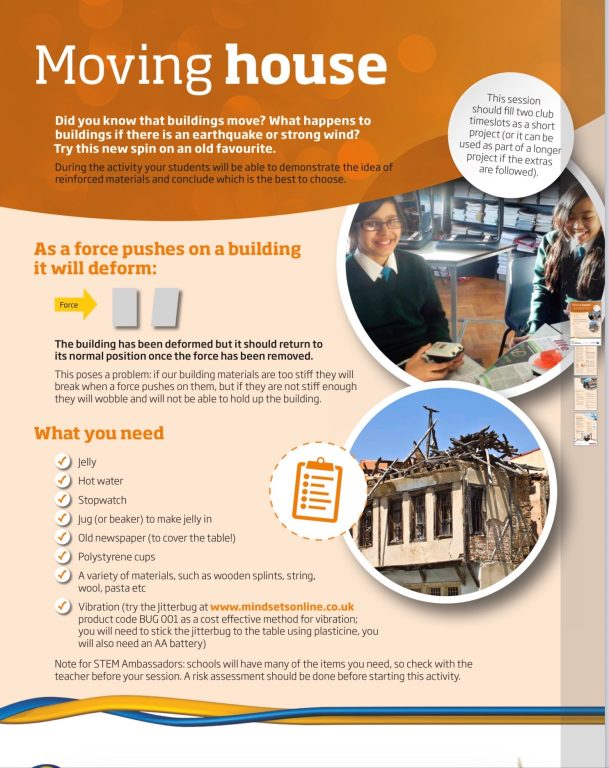Moving House Challenge
This week in Scool Science club we are going to be engineers!
We will be using ideas from The Royal Academy of Engineering:
You can download a pdf document to help you here: Moving House

As well as ideas for the activity, the sheets contain an interview with Angela Crowther, a structural engineer. One of the reasons we are running Scool Science Club is to help our pupils know more about, and consider a wide range of STEM careers.
 |
KEEP SAFE
This activity uses boiling water to make a jelly. Boiling water can scald. Make sure you have an adult helping you make the jelly. Please also be aware of any allergies and food preferences and consider using agar agar or locust bean gelling agents. |
 |

You need to make your jelly more concentrated than you would if you were making it to eat. Use only three quarters of the volume of water stated.
 |
 |
You will need some pots or cups that are the same size. I used old yogurt pots, because they could be cut off the jellies once they had set.
Make up the concentrated jelly. Then pour some jelly into one pot. This will be the jelly you will compare other to.

You will need to choose objects that you will put in the other jellies to try to reinforce them. You can try anything you’ve got at home.
Check your ideas with an adult before you put your chosen objects in the jellies.
Once you’ve put your objects in the pots, you will need to pour in jelly so that each jelly comes to the same level to make it a fair test. Depending on the size of the object you add to the pot, some will use more jelly and some will use less, but all the end jelly structures will be the same size. Tip: if whatever you want to test keeps floating in the jelly, try weighing it down with a coin, until the jelly is set enough to hold it down. Save a bit of the liquid jelly (if it sets heat it up in the microwave), and when you have taken the coin off, top up the jelly, making sure all are the same level. I’m trying cocktail sticks, wool, aluminium foil and dried pasta.

 |
 |
 |
 |
Put your jellies somewhere cool to set, in the fridge if you have space. When the jellies have completely set, carefully remove them from the pots. Standing the pot in some warm water (be careful not to splash water into the jelly) or cutting the pot off the jelly might help.

Now this is the fun bit. You need to find a way of testing your jellies, and you’re going to test them to destruction. It would be a good idea to cover your table or worktop with newspaper to make cleaning up easier.
The Royal Academy of Engineers sheet suggests using a jitterbug. However this is expensive, and you might just want to have a go at shaking the jellies yourself. You could use a hairdryer and try blowing your jellies down. Or you could try putting weights on top of the jellies- you could use tins, coasters, lego bricks, whatever you’ve got that you can safely stack.
Can’t wait to see what you will do…
Obviously in the real world, we don’t construct buildings from jelly. But concrete structures often need reinforcing with metal. Have a look at these videos:
https://www.youtube.com/watch?v=-DuxmoiruMo
https://www.youtube.com/watch?v=A9dOzmRgYWA